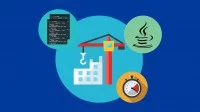
In this article, you can find Maven online courses to elevate your skills.
Maven is a build automation tool used primarily for Java projects. Maven can also be used to build and manage projects written in C#, Ruby, Scala, and other languages. The Maven project is hosted by the Apache Software Foundation, where it was formerly part of the Jakarta Project.
Maven addresses two aspects of building software: how software is built, and its dependencies. Unlike earlier tools like Apache Ant, it uses conventions for the build procedure. Only exceptions need to be specified. An XML file describes the software project being built, its dependencies on other external modules and components, the build order, directories, and required plug-ins. It comes with pre-defined targets for performing certain well-defined tasks such as compilation of code and its packaging. Maven dynamically downloads Java libraries and Maven plug-ins from one or more repositories such as the Maven 2 Central Repository, and stores them in a local cache. This local cache of downloaded artifacts can also be updated with artifacts created by local projects. Public repositories can also be updated.
Maven is built using a plugin-based architecture that allows it to make use of any application controllable through standard input. A C/C++ native plugin is maintained for Maven 2. Alternative technologies like Gradle and sbt as build tools do not rely on XML, but keep the key concepts Maven introduced. With Apache Ivy, a dedicated dependency manager was developed as well that also supports Maven repositories.
Below we prepare a list for you with Maven online courses in order to expand your knowledge.
Learn Maven and Ant the easy way!
Karthikeya Tatavarthi via Udemy
This course is about Apache Ant and Maven. Apache Maven, is a great project management tool that will not only help in automating the project build process, but also a host of other things like, dependency management, versioning, etc. We can keep enhancing the capabilities of Maven by incorporating additional plugins or even write our own custom plugins. This course if for people who want to learn every aspect of the most popular Project management tool (Maven), people who want to be productive in workspace. With the completion of this course you will know how real world Java projects are managed. You will be able to stand on your own, in dealing with these technologies.
★★★★★(5-star rating)
Mastering Apache Maven
Matt Speake via Udemy
With this course you will learn get an excellent understanding of how Maven works under the hood. You will have the ability to create and build your own Java projects with Maven. You will understand where to find dependencies (libraries) to use in your projects and how to include them (unlocking and tapping into the huge Java ecosystem of opensource libraries and components). You will understand how Maven describes projects with the Project Object Model. You will appreciate how Maven resolves dependencies. In addition you’ll get a Maven Cheatsheet of commands you can use to have at your desktop as a handy reference. We’ll be adding more resources too as your requests are heard and your feedback given to make it the best course it can be for you!This course is for newcomers to the Maven build tool. Perhaps you’re one of the following: an experienced Java developer who needs to understand Apache Maven quickly. Those who are new to Java technology and/or have a new job in this area and need to understand how Maven works.
★★★★★(5-star rating)
Java SE Desktop Application with Swing, JPA and Maven
Holczer Balazs via Udemy
When I started software engineering, I always wanted to code without any configurations, version control or build server configurations. Later, I realized that coding is just one part of software engineering: architectural designs, design patterns and the ability to write reusable and loosely coupled software components are much more important parts of programming. At the beginning it was quite hard for me to comprehend the role of these technologies, now I know for ceratain that they are very important as well as useful and can be used on daily basis. So in this course I would like to show you how to separate modules with the help of maven as well as to use the Java Persistence API for database related operations. We will cover Maven in the first section. Then we will consider JPA as a framework. We will learn how to create fancy user interfaces with the Swing framework. At the last section of the course we will wire everything together.
★★★★(4-star rating)
RestAPI Automation with SoapUI, includes Maven,Git & Jenkins
Kumar S via Udemy
Hi! Welcome to the Rest API Automation with SoapUI, Beginners Course, the exclusive course you need to get started and master API Testing and Automation without the need to write any code. In this course you will learn how to easily install and setup/configure Jenkins in windows. How to create Jenkins jobs to execute the tests, without need to copy/paste xml files– edit from SoapUI and directly execute tests from Jenkins. This course will help you master the basics of Rest API testing with SoapUI opensource. You will learn basic to intermediate level SoapUI skills. Most importantly how to write testcases and test steps and verify with assertions. There will be multiple live Testcase writing sessions which will help you in mastering SoapUI easily.
★★★★(4-star rating)
Apache Maven: Beginner to Guru
John Thompson via Udemy
Apache Maven is the most popular Java build tool. Companies and Open Source communities around the world, consider Apache Maven the ‘go–to’ build tool for their Java projects. In this course, you will learn to master Apache Maven. You will become a ‘guru’ using Apache Maven. No previous experience with Apache Maven is required. In just a few lessons, you will be building your first Apache Maven project! In this course, you will: Learn about the Maven Build Lifecycles, Use Maven to build and package Java projects, See how to use Maven with popular alternative JVM languages, including Groovy, Kotlin, and Scala, Configure Maven to run your unit and integration tests written in JUnit 3, JUnit 4, JUnit 5, TestNG, and Spock.Generate source code from XML and JSON Schemas and much more..
★★★★(4-star rating)
Maven Tutorial – Manage Java Dependencies in 20 Steps
in28Minutes Official via Udemy
This course gives a comprehensive coverage of the essential features of Maven. After completing this course, you will have a working knowledge about Maven that you can use at real projects. Thank you Mr. Karanam! Although it is very concise all the main points are covered in some detail. This is the third course from the same author I am following. Great job ?? This course perfectly suits for absolute beginners with Maven who want to get good understanding of Maven basics at good speed and with depth enough at this level. Author covers a right amount of information to remember. Highly recommend. You will learn Maven using a step by step approach with 20 steps. During the course, you will automate these using Maven. Compiling Java Code. Running Unit Tests. Building Jar’s and Wars. Running web applications in Tomcat. Setting up new projects. You will learn following features of Maven with 5 Example Projects on Github.
★★★★(4-star rating)
Java/Apache Maven: Stop Building Java Programs the Hard Way!
Bruce E. Hilton via Udemy
This Maven Course, is an introduction to the widely used Java Build Automation Tool – Apache Maven and is completely hands–on. The course is easy to follow and uses Maven from both the command line and through an Integrated Development Environment (IDE). You will learn how to install and set up the environment correctly, so you can use Maven from the command line and from the Eclipse IDE. Learn how to use Maven in ‘Real World Java‘ scenarios, so you can apply your new knowledge in ‘Real World Java‘ projects, straight away! Using examples you will learn about the Maven Repository, Plugins, LifeCycles, Customizing the LifeCycles and Transitive Dependencies. How to make the most of the Eclipse IDE and its m2Eclipse plugin to view and resolve project dependencies.
★★★★(4-star rating)
Maven Crash Course: Step-by-Step Introduction for Beginners
Jason Taylor via Udemy
The Maven Crash Course is designed to cut academic theory to just the key concepts and focus on basics tasks in Maven in order to be productive quickly. The lessons and examples provided are delivered in a step–by–step, detailed way to ensure mastery of the skills and topics covered. After the setup and installation of Maven, we get hands–on in Getting Started as we create our first Maven project keeping it simple with a minimal demo. Maven Basics covers additional concepts. The concepts are continued in Beyond the Basics as we look into dependencies, repositories and plugins within Maven. Then we improve our project by Unit Testing where we add JUnit tests, deal with (and avoid) testing failures. Finally, the last section of the main part of this course is dedicated to running Maven within Eclipse using the M2Eclipse plugin.During the entire course, we get into a habit of saving our changes periodically using Git source control.
★★★★(4-star rating)
Maven Crash Course
Bharath Thippireddy via Udemy
Apache maven is one of the most popular build and project management tools in the java world.In this course you will master all the core concepts of Maven while working hands on to create a multi module maven java web application project.
★★★★(4-star rating)
Java/Apache Maven: The Truth About Building Java Programs
Bruce E. Hilton via Udemy
This is a follow on course from Java/Apache Maven: Stop Building Java Programs the Hard Way! and continues where Maven 101 left off … By the end of this course you will understand how and why Java and the Apache Maven Build Tool work so well together. You ll be able to work competently with the Apache Maven Build Tool by taking the knowledge you gained from course Java/Apache Maven: Stop Building Java Programs the Hard Way! the next level;Course based on using Maven with Eclipse IDE and command line. Some of the things covered are. Understanding What a Parent POM is and Why your Projects really needs one. How to use Maven Build Properties and Profiles and How they can work together to make your life as a developer so much easier. We take a deep dive into Multi–Module Projects and Discover the difference between mavens ‘Inheritance’ mechanism and its ‘Aggregation’ mechanism and How to get the best out of both with simple and clear examples.
★★★★(4-star rating)












